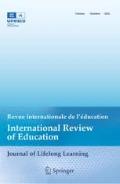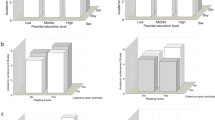Abstract
Extracurricular activities play an important role in the school lives of students. To understand this effect, the authors of this article consider public schools in Azerbaijan and analyse the effect of extracurricular activities on students’ academic performance. They conducted a study investigating three groups of extracurricular activities: sports, fine arts and student clubs. For data on academic performance, they used results of a centralised state school examination which assesses students in two subjects: language of instruction (either Azerbaijani or Russian) and mathematics. The results of this study show that some extracurricular activities have a positive effect on students’ academic performance, while others show no effect. Moreover, the authors consider the number of different extracurricular activities a student takes part in and analyse the significance of this number in predicting student success.
Résumé
L’effet des activités extrascolaires sur les résultats des élèves au niveau de l’enseignement secondaire : le cas de l’Azerbaïdjan – Les activités extrascolaires jouent un grand rôle dans la vie scolaire des élèves. Pour en comprendre l’incidence, les auteurs de cet article se sont penchés sur des écoles publiques en Azerbaïdjan et ont analysé l’effet des activités extrascolaires sur les résultats des élèves. Ils ont réalisé une étude portant sur trois groupes d’activités extrascolaires : le sport, les beaux-arts et les clubs d’élèves. Les données sur les résultats scolaires s’appuient sur les résultats obtenus à un examen centralisé de l’école publique, évaluant les élèves dans deux matières : la langue dans laquelle se déroulent les cours (soit en azerbaïdjanais soit en russe) et les mathématiques. Les résultats de cette étude ont montré que certaines activités extrascolaires avaient un effet positif sur les résultats des élèves, tandis que d’autres n’en avaient pas. En outre, les auteurs ont examiné le nombre d’activités extrascolaires différentes auxquelles se livre un élève et analysé l’importance de ce nombre pour prédire sa réussite scolaire.
Резюме
Влияние дополнительных занятий\ внеучебной деятельности на академическую успеваемость в средних школах: анализ примера в Азербайджане – Аннотация: Внеучебная деятельность играет важную роль в жизни школьников. Для полного понимания следствий дополнительных занятий, авторы данной статьи изучили государственные школы в Азербайджане и проанализировали влияние внеучебных мероприятий на академические показатели и успеваемость учеников. Были изучены три группы внеучебных занятий: спорт, художественное искусство и студенческие клубы. Для сбора данных по академической успеваемости, исследователи использовали результаты государственной системы централизованной экзаменации, которая оценивает показатели учеников по двум предметам: языку преподавания (Азербайджанский или Русский) и математике. Результаты исследования выявили, что некоторые внешкольные занятия имеют положительное действие на академические показатели учеников, тогда как некоторые никак на это не влияют. Более того, авторы учли количество разных дополнительных занятий, в которых школьники принимают участие и изучили значительность этого показателя в прогнозировании успехов школьников.




Similar content being viewed by others
Notes
Children in Azerbaijan enter primary school (years 1–4) when they are six years old. They progress to lower secondary school (years 5–9), completing this part of formal schooling with a state certificate, thereby fulfilling the minimum compulsory school cycle when they are about 14 years old. A few students then engage in an apprenticeship or attend vocational school. But most go on to upper secondary school (years 10–11), completing this part of their formal schooling with another state certificate when they are about 16 years old. Azerbaijani public schools are state-run; attendance and textbooks are free.
Despite achieving independence from the Soviet Union in 1991, the Republic of Azerbaijan still has some schools which have classes/sections with Russian as the language of instruction.
Initially the acronym for Scholastic Aptitude Test, SAT then stood for Scholastic Assessment Test and was later renamed the SAT Reasoning Test (where SAT no longer stands for any three separate words). Often referred to today as simply “the SAT”, it is a standardised college entry exam students need to pass in the United States to gain admission to a college to embark on their undergraduate studies (e.g. for a Bachelor’s degree).
F (named after British statistician Sir Ronald Fisher, 1890–1962) stands for the ratio of two variances; p-value stands for the lowest level of significance at which we can reject the null hypothesis.
t stands for Student’s t-value. It is the test statistic of the distribution of the difference between two sample means.
Named after American statistician Larry V. Hedges, Hedges’ g is a measure of effect size which expresses how much one group differs from another.
Named after American mathematician John Tukey (1915–2000), Tukey’s rule is based on quartiles and identifies values that lie more than 1.5 IQR above Q3 and 1.5 IQR below Q1 as outliers, where IQR is interquartile range, and Q1 and Q3 are first and third quartiles, respectively.
Both Kolmogorov-Smirnov (or KS) and Shapiro-Wilk tests identify whether a sample comes from normal distribution or not.
R-squared is a coefficient of determination, which expresses the proportion of the variance in the dependent variable which can be predicted from the independent variable.
References
Anderman, E. M. (2002). School effects on psychological outcomes during adolescence. Journal of Educational Psychology, 94(4), 795–809. https://doi.org/10.1037/0022-0663.94.4.795.
Black, S. (2002). The well-rounded student: Extracurricular activities and academic performance go hand in hand. American School Board Journal, 189(6), 33–35.
Bohnert, A., Fredricks, J., & Randall, E. (2010). Capturing unique dimensions of youth organized activity involvement: Theoretical and Methodological Considerations. Review of Educational Research, 80(4), 576–610. https://doi.org/10.3102/0034654310364533.
Broh, B. A. (2002). Linking extracurricular programming to academic achievement: Who benefits and why? Sociology of Education, 75(1), 69–95. https://www.jstor.org/stable/3090254.
Camp, W. G. (1990). Participation in student activities and achievement: A covariance structural analysis. The Journal of Educational Research, 83(5), 272–278. https://doi.org/10.1080/00220671.1990.10885969.
Coleman, J. S. (1961). The adolescent society: The social life of the teenager and its impact on education. New York: Free Press of Glencoe.
Cooper, H., Valentine, J. C., Nye, B., & Lindsay, J. J. (1999). Relationships between five after-school activities and academic achievement. Journal of Educational Psychology, 91(2), 369–378. https://doi.org/10.1037/0022-0663.91.2.369.
Craft, S. W. (2012). The impact of extracurricular activities on student achievement at the high school level. Dissertation 543. Hattiesburg, MS: The University of Southern Mississippi, The Aquila Digital Community. https://aquila.usm.edu/dissertations/543.
Creswell, J. W. (2012). Educational research: Planning, conducting, and evaluating quantitative and qualitative research. Boston, MA: Pearson.
Darling, N., Caldwell, L., & Smith, R. (2005). Participation in school-based extracurricular activities and adolescent adjustment. Journal of Leisure Research, 37(1), 51–76. https://doi.org/10.1080/00222216.2005.11950040.
Fejgin, N. (1994). Participation in high school competitive sports: A subversion of school mission or contribution to academic goals? Sociology of Sport Journal, 11(3), 211–230.
Feldman, A. F., & Matjasko, J. L. (2005). The role of school-based extracurricular activities in adolescent development: A comprehensive review and future directions. Review of Educational Research, 75(2), 159–210. https://doi.org/10.3102/00346543075002159.
Finn, J. D. (1989). Withdrawing from school. Review of Educational Research, 59(2), 117–142. https://doi.org/10.3102/00346543059002117.
Fredricks, J. (2012). Extracurricular participation and academic outcomes: Testing the over-scheduling hypothesis. Journal of Youth and Adolescence, 41(3), 295–306. https://doi.org/10.1007/s10964-011-9704-0.
Fredricks, J., & Eccles, J. S. (2005). Developmental benefits of extracurricular involvement: Do peer characteristics mediate the link between activities and youth outcomes? Journal of Youth and Adolescence, 34(6), 507–520. https://doi.org/10.1007/s10964-005-8933-5.
Fujita, K. (2005). The effects of extracurricular activities on the academic performance of junior high students. Undergraduate Research Journal for the Human Sciences (URJHS), 5, Art. 5. https://www.kon.org/urc/urc_research_journal5.html.
Haensly, P. A., Lupkowski, A. E., & Edlind, E. P. (1985). The role of extracurricular activities in education. The High School Journal, 69(2), 110–119.
Hansen, D. M., Larson, R. W., & Dworkin, J. B. (2003). What adolescents learn in organized youth activities: A survey of self-reported developmental experiences. Journal of Research on Adolescence, 13(1), 25–55. https://doi.org/10.1111/1532-7795.1301006.
Holden, R. R. (2007). Socially desirable responding does moderate personality scale validity both in experimental and in non-experimental contexts. Canadian Journal of Behavioral Science, 39(3), 184–201. https://doi.org/10.1037/cjbs2007015.
Holland, A., & Andre, T. (1987). Participation in extracurricular activities in secondary school: What is known, what needs to be known? Review of Educational Research, 57(4), 437–466. https://doi.org/10.3102/00346543057004437.
Joekel, R. (1985). Student activities and academic eligibility requirements. NASSP Bulletin, 69(483), 3–9. https://doi.org/10.1177/019263658506948302.
Jordan, W. J. (2018). Black high school students’ participation in school-sponsored sports activities: Effects on school engagement and achievement. Journal of Negro Education, 68(1), 54–71.
Kariyana, I., Maphosa, C., & Mapuranga, B. (2012). The influence of learners’ participation in school co-curricular activities on academic performance: Assessment of educators’ perceptions. Journal of Social Sciences, 33(2), 137–146. https://doi.org/10.1080/09718923.2012.11893093.
Klesse, E. J. (1994). The third curriculum II: Student activities. Reston, VA: National Association of Secondary School Principals, Division of Student Activities.
Kremer-Sadlik, T., Izquierdo, C., & Fatigante, M. (2010). Making meaning of everyday practices: Parents’ attitudes toward children’s extracurricular activities in the United States and in Italy. Anthropology and Education Quarterly, 41(1), 35–54. https://doi.org/10.1111/j.1548-1492.2010.01066.x.
Lewis, C. P. (2004). The relation between extracurricular activities with academic and social competencies in school age children: A meta-analysis. Doctoral dissertation, College Station, TX: Texas A&M University. Retrieved 4 May 2020 from http://hdl.handle.net/1969.1/2710.
Mahoney, J. L. (2000). School extracurricular activity participation as a moderator in the development of antisocial patterns. Child Development, 71(2), 502–516. https://doi.org/10.1111/1467-8624.00160.
Mahoney, J. L., & Cairns, R. (1997). Do extracurricular activities protect against early school dropout? Developmental Psychology, 33(2), 241–253. https://doi.org/10.1037/0012-1649.33.2.241.
Mahoney, J. L., Cairns, B., & Farmer, T. (2003). Promoting interpersonal competence and educational success through extra-curricular activity participation. Journal of Educational Psychology, 95(2), 409–418. https://doi.org/10.1037/0022-0663.95.2.409.
Marsh, H. W. (1992). Extracurricular activities: Beneficial extension of the traditional curriculum or subversion of academic goals. Journal of Educational Psychology, 85(4), 553–562. https://doi.org/10.1037/0022-0663.84.4.553.
Marsh, H., & Kleitman, S. (2002). Extracurricular school activities: The good, the bad, and the nonlinear. Harvard Educational Review, 72(4), 464–515.
McNeal, R. B. (1995). Extracurricular activities and high school dropouts. Sociology of Education, 68(1), 62–80. https://www.jstor.org/stable/2112764
Moriana, J. A., Alós, F., Alcalá, R., Pino, M. J., Herruzo, J., & Ruiz, R. (2006). Extra-curricular activities and academic performance in secondary students. Electronic Journal of Research in Educational Psychology, 4(1), 35–46.
O’Brien, E., & Rollefson, M. (1995). Extracurricular participation and student engagement. Education policy issues: statistical perspectives. NCES issue brief no. 95-741. Washington, DC: National Center for Education Statistics (NCES), US Department of Education, Office of Educational Research and Improvement. Retrieved 4 May 2020 from https://nces.ed.gov/pubs95/95741.pdf.
Porter, A. C. (1991). Creating a system of school process indicators. Education and Policy Analysis, 13(1), 13–29. https://www.jstor.org/stable/1164455.
Reeves, D. (2008). The learning leader/the extracurricular advantage. Educational Leadership, 66(1), 86–87.
Sallis, J. F., McKenzie, T. L., Kolody, B., Lewis, M., Marshall, S., & Rosengard, P. (1999). Effects of health-related physical education on academic achievement. Research Quarterly for Exercise and Sport, 70(2), 127–138. https://doi.org/10.1080/02701367.1999.10608030.
Shulruf, B. (2010). Do extra-curricular activities in schools improve educational outcomes? A critical review and meta-analysis of the literature. International Review of Education, 56(5–6), 591–612. https://doi.org/10.1007/s11159-010-9180-x.
Shulruf, B., Tumen, S., & Tolley, H. (2008). Extracurricular activities in school, do they matter? Children and Youth Services Review, 30(4), 418–426. https://doi.org/10.1016/j.childyouth.2007.10.012.
Silliker, S. A., & Quirk, J. T. (1997). The effect of extracurricular activity participation on the academic performance of male and female high school students. School Counselor, 44(4), 288–293.
Spady, W. (1970). Lament for the letterman: Effects of peer status and extracurricular activities on goals and achievement. American Journal of Sociology, 75(4), Part 2, 680–702. https://www.jstor.org/stable/2775909.
Valentine, J. C., Cooper, H., & Bettencourt, B. A. (2002). Out-of-school activities and academic achievement: The mediating role of self-beliefs. Educational Psychologist, 37, 245–256. https://doi.org/10.1207/S15326985EP3704_4.
Acknowledgements
The authors gratefully acknowledge the financial support of the Institute of Education of the Republic of Azerbaijan.
Author information
Authors and Affiliations
Corresponding author
Additional information
Publisher's Note
Springer Nature remains neutral with regard to jurisdictional claims in published maps and institutional affiliations.
Rights and permissions
About this article
Cite this article
Abizada, A., Gurbanova, U., Iskandarova, A. et al. The effect of extracurricular activities on academic performance in secondary school: The case of Azerbaijan. Int Rev Educ 66, 487–507 (2020). https://doi.org/10.1007/s11159-020-09833-2
Published:
Issue Date:
DOI: https://doi.org/10.1007/s11159-020-09833-2




